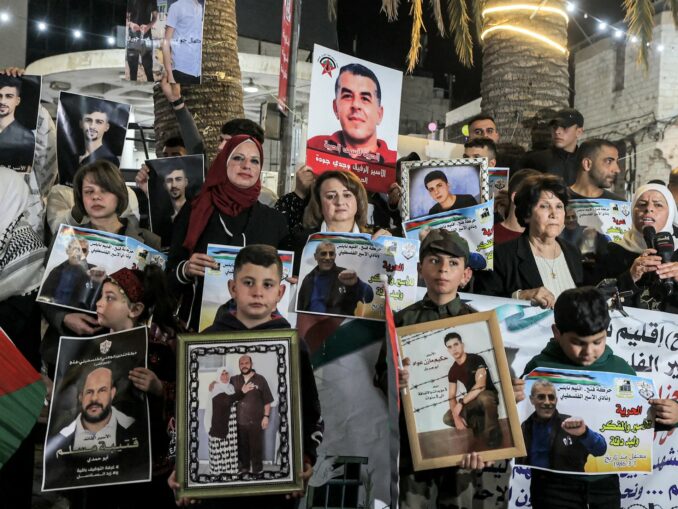Joyous reunions for Palestinian ‘hostages’
Let’s put the current exchange of Israeli “hostages” and Palestinian “prisoners” in some historical perspective.

People gather with the pictures of Palestinian prisoners held in Israeli custody during a rally in solidarity with them in Nablus in the occupied West Bank, April 17, 2023. (Photo: Jaafar Ashtiyeh, Al Jazeera)
On Oct. 7, Hamas seized over 240 people, mostly Israelis, during the raid into illegal settler colonies in occupied Palestine, just miles outside of Gaza. For decades before Oct. 7, hundreds of thousands of Palestinians have passed through Israel’s military injustice system. At some point, nearly every Palestinian family has had a loved one imprisoned in that system.
Many of those recently released were first locked up as teenagers for minor offenses. The arrest by the Israeli Occupation Forces (IOF) could be for no reason at all. Many people taken prisoner this way have been held for years without trial, often without charges. Al Jazeera estimates that Israel has over 10,000 Palestinians detained. (Oct. 26).
To call Israelis “hostages” and Palestinians “prisoners” is in itself a distortion. Since Israeli settler colonialism stole Palestinian land over the last 75 years, any imprisoned Palestinians can be considered hostages of an illegal occupation.
From the other side, the Palestine resistance has taken IOF soldiers hostage in order to arrange an exchange: Free the imprisoned Palestinians and the resistance will free the captured Israeli soldiers. This is happening now. Such exchanges have often taken place during protracted wars.
1971 Attica rebellion
The 1971 rebellion of 1,000 incarcerated workers, nearly all Black and Brown, at the Attica prison in upstate New York began with their seizure of 39 guards and correctional workers as hostages on Sept. 9. Only by taking hostages could those imprisoned get the attention of politicians and corporate media to air their demands.
When the capitalist state power sent in heavily armed police to crush the rebellion, it not only killed 29 inmates but also killed 10 of the guards who had been taken hostage when it retook the prison four days later on Sept. 13. It should be noted that the cops and prison officials lied and claimed that the rebellious inmates had slit the throats of the hostages –– it turned out all had been shot by the cops. This too had similarities to what transpired on Oct. 7.
While the current exchanges between Palestine and Israel may be getting the most worldwide publicity, they are far from the first. There have been many similar exchanges over the past 75 years.
Despite Israel’s attempts to delay and even derail the process, since Nov. 24, the Israeli state has released at least 111 Palestinians in the first three days. The majority of those released have been children, along with the women who have been imprisoned the longest. Many were arrested when they were teenagers and, often held without charges or hearings. Several have served long sentences up to 15 years or more!
Hamas has released 39 Israelis along with 19 foreign nationals, including workers from Thailand and the Philippines.
Heartwarming reunions
The Israeli state has made it as difficult as possible for Palestinians to greet those released. On Nov. 24, Israeli forces interrogated and harassed family members and tear gassed hundreds of people, including journalists, waiting for the 39 released Palestinian prisoners outside the Ofer Prison in Ramallah on the West Bank. Despite these repressive acts, Israel has been unable to stop the heartwarming reunions of many who had not seen each other for years.
Resistance News Network has aired many of these reunions. When young women and youth coming out of prisons carrying Hamas flags reunited with their families and thanked the resistance, their joy was palpable.
It was also interesting to watch the news feed on RNN as Hamas released the Israeli children and elderly women hostages who shook hands with the resistance members before getting into vans. They showed no fear of their captors.
Israel tried to sabotage cease-fire
Even before the first exchange of hostages and the temporary cease-fire, the Israeli occupation regime seemed to be doing everything possible to sabotage the process. The Israelis delayed releasing prisoners and prevented life-saving humanitarian aid from entering Gaza.
First Israel delayed the day of the exchange and carried out more bombings. The occupation forces arrested the head of Al-Shifa Hospital after totally destroying the facility. Then, despite the declaration of a cease-fire in Gaza, the IOF fired on Palestinians who attempted to return to their homes in the north of the Gaza Strip, killing several.
Israeli authorities limited the size of promised convoys of vital aid, with little aid reaching the north where the need is the greatest. Israel dropped leaflets on Gaza warning people not to return to their homes, but most people ignored them, finding other uses for the paper.
With Israel’s reputation for historically violating treaties and international laws, that it flouted the agreement comes as no surprise. Only when Hamas declared that no prisoner exchange would happen on Nov. 24 because of Israel’s violations were Qatar and other third-party negotiators able to restore the agreement.
Caught up in Netanyahu’s lies
Reports in the Hebrew-language media continue to surface showing that the IOF was largely responsible for most of the deaths Oct. 7 at the Be’eri kibbutz. They report that a Zionist warplane bombed the kibbutz, intending to kill the Hamas forces.
As more eyewitness testimony is released, the question arises on how Prime Minister Benjamin Netanyahu’s regime, already under pressure from families of those held hostage, will react to reports from hostages when they return.

